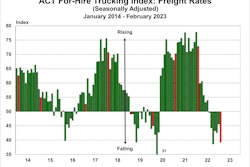Readers can download all 40-plus slides from Overdrive and ATBS' Friday, March 31, presentation via the page at this link to help follow along with the video of the presentation above.
While gross owner-operator revenue across all segments was up nearly 10% in 2022 compared to 2021, net income was down by the same percentage on average during the year, according to data from its many thousands of owner-operator clients crunched by business services provider ATBS.
This data was presented Friday, March 31, at the Mid-America Trucking Show in Louisville, Kentucky, in an Overdrive’s Partners in Business seminar, accompanying the release of the 2023 edition of the owner-operator business manual co-produced with ATBS.
The biggest reason revenue gains didn't translate to bottom-line income? Fuel costs skyrocketing, of course, but that's not all there is to it. According to ATBS, average gross revenue was up $16,229 last year, while average fuel costs increased $15,726, almost fully offsetting the increased revenue. Additionally, maintenance costs were up, despite a big fall in miles run.
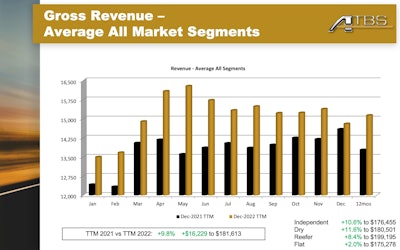 Leased dry van haulers and independents saw the biggest year-over-year gross revenue gains, as shown at the bottom right of this chart. Bars compare averages for the trailing twelve months (TTM) comprising all of 2022 and 2021 at yearend.
Leased dry van haulers and independents saw the biggest year-over-year gross revenue gains, as shown at the bottom right of this chart. Bars compare averages for the trailing twelve months (TTM) comprising all of 2022 and 2021 at yearend.
Hosted said the biggest surprise in 2022 was that miles driven were down 11% year over year, equating to almost 11,000 miles less than in 2021. “That’s counterintuitive,” he said, given that costs were increasing and rates were falling during much of the year. Hosted noted that after the last freight and rates boom in 2018, the trucking environment got tougher in 2019, and miles picked up.
 ATBS Vice President Mike Hosted (right) presented Friday, March 31, as part of Overdrive's Partners in Business seminar at the Mid-America Trucking Show with Overdrive contributor and owner-operator biz coach Gary Buchs.
ATBS Vice President Mike Hosted (right) presented Friday, March 31, as part of Overdrive's Partners in Business seminar at the Mid-America Trucking Show with Overdrive contributor and owner-operator biz coach Gary Buchs.
Following the banner year of 2021 for owner-operator income, as things got tougher last year with fuel and maintenance costs soaring and rates dropping, there hasn’t yet been that uptick in miles to offset the losses, Hosted noted.
Looking at the last five years, average owner-operator miles, according to ATBS, have fallen from around 108,000 a year, as of the second quarter of 2018, to 85,000 for the trailing twelve months (TTM) at the end of 2022.
All told, “we’ve lost 23,000 miles for the average owner-operator over the last five years,” Hosted said. With an estimated 350,000 owner-operators in the U.S. leased to motor carriers or independent, that represents a reduction of almost 8 billion miles of capacity among owner-operators over the last five years, he added.
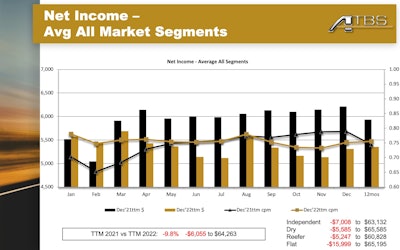 While revenues were up across all segments, income was down due in large part to rising fuel and maintenance costs and lower rates. Maintenance costs only increased by about 2.4% in 2022 over 2021, but owner-operators' average miles were down 11%. Owner-operators were thus paying considerably more for maintenance during a year in which you'd expect a drop in expenses with less utilization. Anecdotally, maintenance and parts delays appear a likely contributor to those fewer miles run, too.
While revenues were up across all segments, income was down due in large part to rising fuel and maintenance costs and lower rates. Maintenance costs only increased by about 2.4% in 2022 over 2021, but owner-operators' average miles were down 11%. Owner-operators were thus paying considerably more for maintenance during a year in which you'd expect a drop in expenses with less utilization. Anecdotally, maintenance and parts delays appear a likely contributor to those fewer miles run, too.
Another factor Buchs noted: government loan programs and other stimulus during COVID that helped pad businesses' bank accounts. “Still today, I do meet and talk to owners that are living off that money,” he said. “So that’s influencing them not to work, because as long as they have some cash in the bank, they feel like they’re OK.”
Ultimately, however, Buchs said when there’s opportunity in trucking to make more money, “you need to be ready to take advantage of it.”
'The extra load'
Though the bottom line took a beating last year, along with rates all around trucking, profit measured per-mile remained relatively stable, just slightly below the full-year 2021 average, as shown in the chart above. All things being equal, had owner-operators not lost the production they did in 2022, things could have been different.
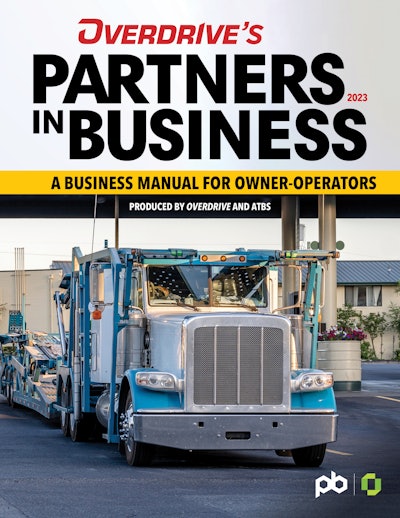 Download the updated, 2023 version of the Partners in Business book, a self-help resource for owner-operators from start-up to expansion as a small fleet, via this link.
Download the updated, 2023 version of the Partners in Business book, a self-help resource for owner-operators from start-up to expansion as a small fleet, via this link.
"That extra load is so important," said Buchs. "You’ve already hit your fixed costs, so all you’re paying really is variable costs on that extra load. Meaning the profitability on the extra load is considerably higher” for a given period.
Adding just one extra load a month is like working an extra month for the whole year, diluting the impacts of rising costs, he added.
If it's possible to combine that with a reduction in speed, or other methods to increase your fuel mileage, income gains will only increase.
“The best operators are doing both of those,” Hosted said. “They’re taking that extra load, but they’re also slowing it down to get that better fuel mileage.”
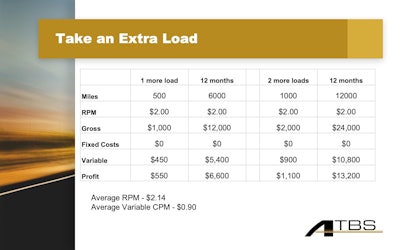 If, for example, you take one extra load a month that nets you $550, you’ll be up almost $7,000 by the end of the year. This calculation can be done for a load of any length, but the point stands that if you’re able to work your schedule to get in at least one extra load each month, it can make a big difference in your income by the end of the year.
If, for example, you take one extra load a month that nets you $550, you’ll be up almost $7,000 by the end of the year. This calculation can be done for a load of any length, but the point stands that if you’re able to work your schedule to get in at least one extra load each month, it can make a big difference in your income by the end of the year.
“You run another load, you made $1,000, but it cost you $450 to get there,” Hosted said. “Every dollar you generate costs you a little bit of money that’s not for profit. Every dollar you save goes directly in your pocket. It’s pure profit.”
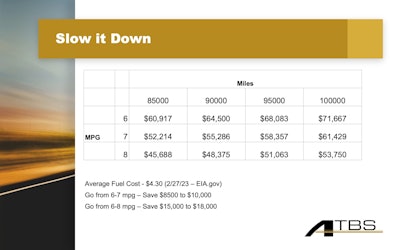 Based on the numbers from the previous slide about the extra profit gained from one or two extra loads a month, if you combine that with increased fuel mileage, you’re looking at a combined boost to your income of $15,000 or more.
Based on the numbers from the previous slide about the extra profit gained from one or two extra loads a month, if you combine that with increased fuel mileage, you’re looking at a combined boost to your income of $15,000 or more.
Delve deeper into the numbers via the video of the Partners in Business seminar at the top.
Find more detailed information about the ins and outs of success as an owner-operator business with a myriad of other topics in the Overdrive/ATBS-coproduced "Partners in Business" manual for new and established owner-operators, a comprehensive guide to running a small trucking business. Click here to download the updated 2023 edition of the Partners in Business manual free of charge.


